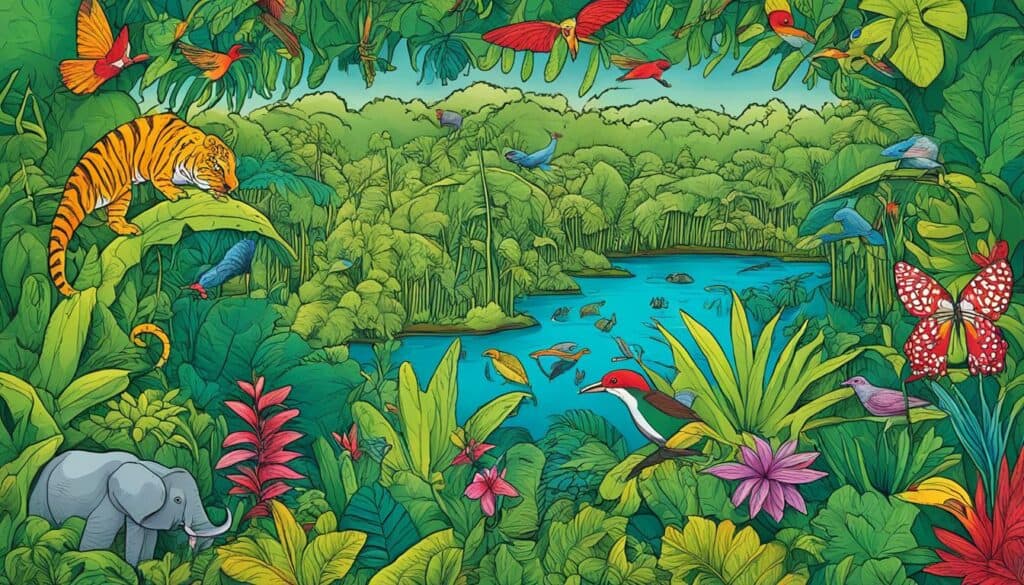
Exploring the Hidden Treasures of the Congo Rainforest
Did you know that the Congo Basin is the world’s second-largest river basin, covering over 1.3 million square miles? Within this vast expanse lies the majestic La foret équatoriale du Congo, the second largest rainforest in the world. Spanning from about 4° N to 5° S, this tropical rainforest stretches across the Republic of the Congo, the Democratic Republic of the Congo, and other countries in Central Africa.

Key Takeaways
- La foret équatoriale du Congo, also known as the Congo rainforest, is the second largest rainforest in the world.
- Covering over 1.3 million square miles, the Congo Basin is the world’s second-largest river basin.
- The rainforest is home to diverse flora and fauna, including endangered species like the okapi, African forest elephant, and western lowland gorilla.
- The Congo rainforest plays a crucial role in mitigating climate change as a carbon sink.
- Deforestation, infrastructure development, and climate change pose significant threats to the Congo rainforest and its ecosystem.
The Importance of the Congo Rainforest Ecosystem
The tropical rainforest of Congo, also known as the Congo rainforest ecosystem, is a remarkable natural wonder. This vast expanse of biodiversity is home to over 10,000 plant species and a diverse array of animal species. It provides a crucial habitat for iconic creatures such as the okapi, African forest elephant, and bonobo.
The Congo rainforest also plays a vital role in regulating the Earth’s climate. As one of the world’s largest carbon sinks, it absorbs vast amounts of carbon dioxide and releases oxygen, helping to mitigate climate change. Additionally, the rainforest influences regional and global weather patterns through its impact on rainfall and temperature.
Not only is the Congo rainforest essential for the health of our planet, but it also sustains the livelihoods of millions of people. Local communities depend on the rainforest for food, medicine, and other essential resources, highlighting its significance beyond environmental conservation.
The Congo rainforest ecosystem is a treasure trove of biodiversity, providing a habitat for numerous plant and animal species. Its preservation is crucial for the well-being of both wildlife and local communities.
Unfortunately, the Congo rainforest ecosystem faces grave threats. Deforestation, primarily driven by commercial logging and agriculture, poses a significant risk to its integrity. Illegal logging exacerbates this problem further. Additionally, habitat destruction due to human activities has led to the loss of key habitats and displacement of wildlife.
| Threats to the Congo Rainforest | Impact |
|---|---|
| Deforestation | Loss of habitat and biodiversity |
| Illegal logging | Depletion of valuable timber resources |
| Habitat destruction | Displacement of wildlife and loss of critical ecosystems |
Conservation efforts aimed at safeguarding the Congo rainforest are essential. It requires a multi-faceted approach involving governments, local communities, and international cooperation. By implementing sustainable land use practices, promoting responsible logging, and engaging in habitat restoration, we can work towards preserving this invaluable ecosystem for future generations.
Conservation Efforts in the Congo Rainforest
Conservation efforts in the Congo rainforest are essential to preserve its biodiversity and ecological integrity. Many organizations and governments are working together to protect the rainforest and promote sustainable land use practices.
Protected areas, national parks, and wildlife reserves have been established to safeguard the rainforest and its inhabitants.
Table: Key Conservation Efforts in the Congo Rainforest
| Conservation Initiatives | Description |
|---|---|
| Combatting deforestation | Implementing measures to reduce illegal logging and promote sustainable timber harvesting practices. |
| Engaging local communities | Involving indigenous communities in conservation decision-making and promoting sustainable livelihoods. |
| Establishing protected areas | Creating national parks, wildlife reserves, and other protected areas to safeguard the rainforest’s biodiversity. |
| International agreements | Participating in initiatives like the Cop15 summit to secure funding and support for conservation efforts. |
| Research and monitoring | Continued scientific research to better understand the rainforest ecosystem and develop effective conservation strategies. |
The involvement of indigenous communities in conservation decision-making processes is crucial for the success of these efforts. By combining traditional ecological knowledge with modern scientific approaches, conservationists can develop sustainable solutions.
“Conservation is not an option, it’s a necessity. We must protect the Congo rainforest’s incredible biodiversity for future generations.” – Dr. Jane Goodall
Continued research and monitoring are also vital to better understand the rainforest ecosystem and develop effective conservation strategies.

Threats to the Congo Rainforest
The Congo rainforest, also known as La foret equatoriale du congo, is facing numerous threats that endanger its ecological balance and biodiversity. These threats include deforestation, habitat loss, climate change, and various human activities.
Deforestation and Habitat Loss
Deforestation is one of the most significant threats to the Congo rainforest. The expansion of agriculture, including commercial farming and palm oil plantations, leads to the clearing of vast areas of the rainforest. This deforestation disrupts habitats and fragments the ecosystem, negatively impacting the wildlife that depends on the forest for survival.
“The rainforest is the habitat of numerous species, including endangered ones such as gorillas and elephants. Deforestation poses a grave risk to their survival.” – Dr. Jane Goodall
Climate Change
The Congo rainforest plays a vital role in regulating the Earth’s climate by absorbing carbon dioxide and releasing oxygen. However, climate change poses a threat to this delicate balance. Changes in precipitation patterns and temperature can harm the rainforest ecosystem and disrupt the life cycles of many plant and animal species.
Illegal Logging and Poaching
Illegal logging and poaching are rampant in the Congo rainforest, targeting valuable timber and iconic wildlife species. These activities not only contribute to the loss of biodiversity but also disrupt the ecological dynamics of the forest. Endangered species like gorillas, elephants, and other wildlife face the risk of extinction due to these illegal practices.
Infrastructure Development
Infrastructure development, such as road construction and mining, poses a significant risk to the Congo rainforest. These activities fragment the forest, create access for further exploitation, and disrupt wildlife migration patterns. The construction of roads also opens up previously inaccessible areas to illegal logging and poaching.
Increased Demand for Natural Resources
The growing demand for natural resources, including timber and minerals, puts additional pressure on the Congo rainforest. This demand drives unsustainable extraction practices, leading to further deforestation and habitat destruction. It is essential to address the root causes of this demand to protect the rainforest ecosystem.
In order to ensure the survival and conservation of the central African rainforest and its diverse wildlife, a multi-faceted approach involving governments, local communities, and international cooperation is necessary. It is crucial to implement effective measures to combat deforestation, illegal logging, and poaching. Additionally, efforts should focus on promoting sustainable land use practices, raising awareness about the value of the rainforest, and providing alternative livelihood options for local communities. The protection of the Congo rainforest is not only vital for the wildlife and ecosystems it supports but also for the overall health and well-being of our planet.
The Future of the Congo Rainforest
The conservation of the Congo Equatorial Rainforest is of paramount importance for the long-term well-being of the region and the planet as a whole. It requires collective efforts and sustainable management practices to ensure its preservation for future generations.
Increased funding is necessary to support conservation initiatives and promote sustainable development in the Congo rainforest. These funds can be used to implement measures that address deforestation, illegal activities, and habitat loss, while also supporting scientific research and monitoring.
Strengthening legal frameworks and enforcing stringent laws are crucial to combat illegal activities such as logging and poaching in the rainforest. By holding accountable those who engage in these destructive practices, we can protect the fragile ecosystem of the Congo rainforest.
Promoting sustainable land use practices and offering alternative livelihoods to local communities can reduce the pressure on the rainforest. By providing economic opportunities that are not reliant on resource exploitation, we can incentivize conservation efforts and alleviate the dependency on activities that harm the environment.
Integrating traditional ecological knowledge and recognizing indigenous rights are essential in developing effective conservation strategies. Indigenous communities have deep-rooted connections with the rainforest and possess valuable knowledge about its ecosystems. By involving them in decision-making processes, we can ensure the long-term success of conservation efforts.
International cooperation and partnerships are vital for addressing the global challenges posed by climate change and biodiversity loss. By working together, nations can share resources, expertise, and best practices to protect the Congo rainforest and other critical ecosystems around the world.
The conservation of the Congo rainforest is not only vital for its biodiversity and ecological significance but also for the well-being of local communities who rely on it for their livelihoods. By safeguarding this unique natural heritage, we can uphold our responsibility to protect the planet and secure a sustainable future for all.
Biodiversity in the Congo Rainforest
The Congo rainforest is a treasure trove of biodiversity, making it one of the world’s ecological hotspots. This vast ecosystem is estimated to be home to thousands of plant and animal species, many of which are endemic to the region.
The rainforest provides habitat for iconic species such as gorillas, chimpanzees, elephants, and numerous bird species. It serves as a living laboratory for scientists studying the complexities of tropical ecosystems and their ecological interactions.
The preservation of the rainforest’s biodiversity is crucial for maintaining the balance of ecosystems and ensuring the long-term survival of species. However, the biodiversity of the Congo rainforest faces significant threats from habitat loss and climate change.
“The biodiversity of the Congo rainforest is truly remarkable. It is a haven for unique and irreplaceable species, many of which are found nowhere else on Earth. Safeguarding this biodiversity is not only an ecological imperative but also a cultural and ethical responsibility.”
Habitat loss due to deforestation and human activities poses a substantial threat to the diverse range of flora and fauna in the rainforest. The clearing of land for agriculture, logging, and infrastructure development fragments habitats and disrupts the fragile balance of the ecosystem.
Climate change, including rising temperatures and altered rainfall patterns, further exacerbates the challenges faced by the rainforest’s biodiversity. These changes can impact the distribution and survival of species, leading to local extinctions and irreversible changes to the ecosystem.
To protect the biodiversity of the Congo rainforest, conservation efforts must be prioritized. This includes the establishment and management of protected areas and national parks, as well as sustainable land use practices that promote coexistence between humans and nature.
The involvement of local communities in conservation initiatives is crucial. Their traditional knowledge and sustainable practices can contribute to the preservation of biodiversity while supporting their livelihoods.
Furthermore, international cooperation and funding are essential for the success of conservation efforts in the Congo rainforest. Collaborative research, data sharing, and capacity-building initiatives can strengthen conservation strategies and promote the sustainable use of resources.
“The biodiversity of the Congo rainforest is a global treasure. By protecting and preserving this remarkable ecosystem, we not only safeguard the survival of countless species but also promote the well-being of local communities and maintain the ecological balance of our planet.”
To further illustrate the biodiversity of the Congo rainforest, let’s take a look at the following table:
| Species | Number | Status |
|---|---|---|
| Gorillas | Approximately 200,000 | Endangered |
| Chimpanzees | Approximately 150,000 | Endangered |
| Elephants | Approximately 22,000 | Endangered |
| Bird species | Over 1,000 | Various statuses |
Table: Biodiversity of the Congo Rainforest
Conclusion: Exploring the Hidden Treasures of the Congo Rainforest
The Congo rainforest, known as La foret equatoriale du congo, is a treasure trove of biodiversity and a vital ecosystem. Its immense size and rich biodiversity make it a global priority for conservation efforts. However, the rainforest is under significant threat from deforestation, habitat loss, and climate change.
The conservation of the Congo rainforest is crucial for the survival of numerous species and the well-being of local communities who depend on it for their livelihoods. To achieve this, sustainable land use practices, strong legal frameworks, and active involvement of the local communities are essential. It is through collective action, both at the local and international level, that we can preserve the biodiversity and ecological integrity of this precious natural heritage.
Protecting the biodiversity of the Congo rainforest is not only a matter of ecological importance but also a moral responsibility. By safeguarding this unique ecosystem, we are ensuring a healthier planet for future generations. Let us recognize the significance of the Congo rainforest and work together to conserve and preserve its biodiversity for the benefit of all.
FAQ
What is La foret equatoriale du congo?
La foret equatoriale du congo, also known as the Congo rainforest, is the second largest rainforest in the world and stretches from about 4° N to 5° S, spanning the Republic of the Congo, the Democratic Republic of the Congo, and other countries in Central Africa.
Why is the Congo rainforest ecosystem important?
The Congo rainforest ecosystem is of immense importance due to its rich biodiversity. It is home to more than 10,000 plant species and a wide array of animal species. The rainforest plays a crucial role in regulating the Earth’s climate, providing habitat for iconic species, and supporting the livelihoods of millions of people.
What are the threats to the Congo rainforest?
The Congo rainforest faces threats from deforestation, habitat loss, climate change, illegal logging, poaching, and infrastructure development. These activities endanger the unique biodiversity of the rainforest and disrupt the delicate balance of its ecosystem.
What are the conservation efforts in the Congo rainforest?
Many organizations and governments are working together to protect the Congo rainforest. Conservation efforts focus on combating deforestation, promoting sustainable logging practices, establishing protected areas, engaging local communities, and integrating indigenous knowledge in decision-making processes.
What is the future of the Congo rainforest?
The future of the Congo rainforest depends on collective action and the recognition of its importance as a global natural heritage. Increased funding for conservation, strengthening legal frameworks, promoting sustainable land use practices, and involving local communities are essential for its long-term preservation.
What is the biodiversity of the Congo rainforest?
The Congo rainforest is renowned for its exceptional biodiversity. It is estimated to be home to thousands of plant and animal species, many of which are endemic to the region. Gorillas, chimpanzees, elephants, and numerous bird species are among the iconic species found in the rainforest.
Why is the conservation of the Congo rainforest important?
The conservation of the Congo rainforest is crucial for maintaining the balance of ecosystems, preserving unique species, supporting the livelihoods of local communities, and addressing global challenges such as climate change and biodiversity loss. It is a collective responsibility to protect this global natural treasure.
Related read: Lake Victoria: Africa’s Largest Freshwater Lake







